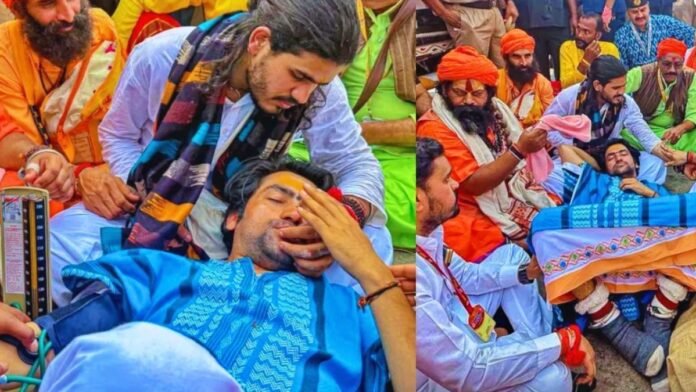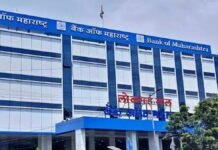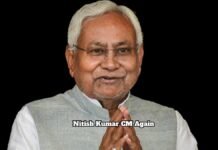
Key Points
- Pandit Dhirendra Krishna Shastri collapsed on November 13, 2025, during sixth day of Sanatan Ekta Padyatra in Hodal, Haryana
- Health deteriorated with 100-degree fever for second consecutive day after similar incident on November 12
- Doctors advised two days rest but spiritual leader continued 150-kilometer march from Delhi to Vrindavan
- Padyatra scheduled to enter Uttar Pradesh on November 13 afternoon with grand welcome planned at border
- High-profile participants include cricketer Shikhar Dhawan, Union Minister Manohar Lal Khattar, WWE wrestler The Great Khali
- Muslim Sarpanch welcomed Shastri, who called for education reform in Muslim community
- BJP MLA Harendra Singh’s controversial statement on Delhi car blasts went viral during yatra
- March covers 8 kilometers in Haryana on final day, completing six-day journey through state
- Padyatra scheduled November 7-16, 2025, aims to promote Sanatan unity and social harmony
Pandit Dhirendra Krishna Shastri, the 29-year-old head priest of Bageshwar Dham in Madhya Pradesh, experienced his second major health crisis in as many days on Thursday, November 13, 2025, during the sixth and final day of the Sanatan Ekta Padyatra’s journey through Haryana. The spiritual leader collapsed near Hodal Grain Market while leading thousands of devotees on the march, forcing him to lie down on the road as supporters rushed to provide medical assistance.
According to eyewitnesses and social media reports, Shastri appeared visibly exhausted and was laid out on the roadside, where his team attended to him. The incident occurred just hours before the padyatra was scheduled to cross the state border into Uttar Pradesh, where elaborate preparations had been made for a grand welcome ceremony marking the march’s entry into the next phase of its journey to Vrindavan.
Medical Advice Ignored Despite High Fever
The latest health episode follows a similar incident on Wednesday, November 12, when Dhirendra Shastri’s condition suddenly deteriorated during the march. Medical personnel who examined him on site recorded a fever of 100 degrees Fahrenheit, a concerning development given the physical demands of leading a walking pilgrimage covering approximately 150 kilometers over ten days.
Doctors who treated Shastri on Wednesday strongly advised him to take complete rest for at least two days to allow his body to recover from the fever and exhaustion. However, displaying the determination that has made him a controversial yet popular figure among his followers, the spiritual leader refused medical advice and insisted on continuing the padyatra without interruption, citing his commitment to completing the spiritual journey as planned.
Health experts note that continuing strenuous physical activity while suffering from a high fever can lead to serious complications, including dehydration, heat exhaustion, and potential cardiac stress, particularly concerning for someone leading thousands of followers through November’s varying weather conditions in northern India.
The Sanatan Ekta Padyatra: A Ten-Day Spiritual March
The Sanatan Ekta Padyatra, which translates to “Sanatan Unity March,” commenced on November 7, 2025, from Delhi with the ambitious goal of reaching Vrindavan by November 16. The 150-kilometer walking pilgrimage has been designed as both a spiritual journey and a social movement aimed at promoting Hindu unity, religious harmony, and what organizers describe as the preservation of Sanatan Dharma values in contemporary India.
Thursday’s route through Haryana covered approximately 8 kilometers, marking the padyatra’s final stretch through the state before crossing into Uttar Pradesh. Over the preceding six days, the march has wound through various towns and villages in Haryana, attracting thousands of participants and onlookers at each stop. The journey has been meticulously planned with rest stops, medical facilities, and support vehicles following the walking procession.
Preparations for the UP border crossing include elaborate decorations, traditional welcome ceremonies, and arrangements for the significantly larger crowds expected as the march enters Uttar Pradesh, where Dhirendra Shastri commands a massive following, particularly in the Hindi-heartland region leading to the sacred city of Vrindavan.
Star-Studded Participation Elevates Profile
The Sanatan Ekta Padyatra has attracted unprecedented attention due to the participation of several high-profile personalities from sports, politics, and entertainment. Former Indian cricket team opener Shikhar Dhawan, who announced his retirement from international and domestic cricket in August 2024, joined the march, lending his celebrity status to the spiritual cause and attracting significant media coverage.
Union Minister and former Haryana Chief Minister Manohar Lal Khattar also participated in the padyatra during its passage through Haryana, providing political legitimacy to the event. His presence signals the BJP’s tacit endorsement of Dhirendra Shastri’s activities, despite the spiritual leader’s occasionally controversial statements that have created challenges for party leadership.
Perhaps most unexpectedly, renowned WWE wrestler Dalip Singh Rana, known globally as “The Great Khali,” made an appearance during the march. The 7-foot-1-inch wrestling icon’s participation generated widespread social media buzz and attracted younger audiences who might not typically engage with traditional religious events, demonstrating the organizers’ savvy in building a diverse participant base.
Muslim Sarpanch’s Welcome Sparks Community Dialogue
In a moment that organizers have highlighted as evidence of the padyatra’s inclusive message, a Muslim Sarpanch (village head) welcomed Dhirendra Shastri during the march’s passage through his jurisdiction. The encounter provided Shastri an opportunity to address what he characterized as concerns about the Muslim community’s image in contemporary India.
Speaking to the Sarpanch, Shastri stated that “questions are raised about his community every time” and urged him to “educate your youth” and “change your education policy.” While supporters framed these remarks as constructive engagement promoting communal harmony, critics have questioned whether such statements, coming from a Hindu religious leader to a Muslim representative, might carry undertones of superiority or place disproportionate responsibility for communal tensions on minority communities.
The exchange has generated significant social media discussion, with supporters praising it as evidence of interfaith dialogue and critics suggesting it reflects problematic assumptions about Muslim communities requiring special guidance from Hindu leaders. The incident underscores the complex and often controversial nature of Dhirendra Shastri’s public persona and messaging.
Controversial BJP MLA Statement During Padyatra
The padyatra’s passage through Haryana coincided with controversial remarks by BJP MLA Harendra Singh regarding the recent car bombing near Red Fort in Delhi that killed 12 people and injured 20 others. When asked about the terrorist attack during the march, Singh stated, “This is the mentality of some people. Such small blasts will not achieve anything.”
Singh’s characterization of a terrorist attack that claimed a dozen lives as a “small blast” sparked immediate outrage on social media, with opposition parties and citizens condemning what they perceived as insensitivity toward victims and their families. The statement went viral during the padyatra, creating an unwanted distraction from the march’s stated spiritual objectives and raising questions about the political messaging surrounding the event.
The BJP has not issued an official response to Singh’s remarks, though party insiders suggest the comment was poorly worded rather than deliberately insensitive. Nevertheless, the incident highlights the challenges of maintaining message discipline during large-scale public events involving multiple political figures with varying communication skills.
Dhirendra Shastri: Controversial Figure with Mass Appeal
Pandit Dhirendra Krishna Shastri, born on July 4, 1996, in Chhatarpur district of Madhya Pradesh, has emerged as one of contemporary India’s most polarizing religious figures. Coming from a modest background and educated in government schools, Shastri rose to prominence as the head of Bageshwar Dham, where he conducts spiritual discourses and claims to possess divine powers to diagnose devotees’ problems and provide solutions.
His rapid rise to fame, particularly among Hindu youth, has been facilitated by the sophisticated use of social media platforms, where videos of his discourses and claimed miracles regularly go viral. Supporters view him as a dynamic young voice revitalizing Hindu spirituality for modern audiences, while critics accuse him of promoting superstition and making unverifiable claims about supernatural abilities.
Shastri has faced previous health challenges related to his grueling schedule of public appearances, travel, and extended speaking engagements. Reports from October 2024 revealed that he was dealing with significant hair loss attributed to poor lifestyle choices, including irregular eating habits, late nights, excessive consumption of sweets, and protein deficiency in his diet, leading him to consult a Mumbai-based hair transplant specialist.
Padyatra as Faith Journey and Social Movement
Organizers have positioned the Sanatan Ekta Padyatra as more than a traditional religious pilgrimage, framing it as a broader movement for “faith, social harmony, and the unity of Sanatan.” This messaging attempts to present Hindu religious mobilization within a framework of national integration and social cohesion rather than exclusively religious assertion.
The choice of Vrindavan as the destination carries deep symbolic significance, as the holy city is considered the childhood home of Lord Krishna and one of Hinduism’s most sacred pilgrimage sites. By completing the march at Vrindavan during an auspicious period, Shastri aims to reinforce his spiritual credentials and position himself within the lineage of Hindu saints who have undertaken similar journeys throughout history.
The padyatra’s timing, route, and messaging occur against the backdrop of ongoing debates about religious identity, secularism, and communal relations in contemporary India. While supporters present it as a legitimate expression of Hindu devotion and cultural pride, some analysts view such large-scale religious mobilizations as contributing to the communalization of public space and potentially marginalizing minority communities.
What Lies Ahead: Final Push to Vrindavan
Despite his deteriorating health, Dhirendra Shastri appears determined to complete the remaining days of the Sanatan Ekta Padyatra, which is scheduled to reach Vrindavan on November 16, 2025. The crossing into Uttar Pradesh marks a critical phase, as the march will traverse areas where Shastri enjoys his largest following, potentially drawing significantly larger crowds than those witnessed in Haryana.
The final three days of the journey will test both Shastri’s physical endurance and his organizational team’s ability to manage what could become massive crowds in the towns and villages between the UP border and Vrindavan. Medical personnel accompanying the march have reportedly been placed on high alert following the repeated health incidents, with contingency plans in place should Shastri’s condition require emergency hospitalization.
For his millions of followers, the completion of the padyatra despite health challenges will likely enhance Shastri’s image as a dedicated spiritual leader willing to sacrifice personal comfort for religious duties. For critics, the incidents raise questions about the wisdom of undertaking physically demanding pilgrimages without adequate attention to health precautions and medical advice. As the march enters its final phase, all eyes will be on whether Dhirendra Shastri can maintain both his health and the momentum of what has become one of 2025’s most talked-about religious events in northern India.








































